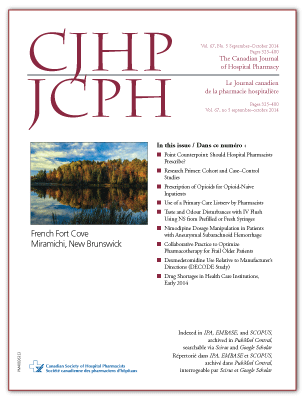Incidence of and Factors Associated with Manipulation of Nimodipine Dosage in Patients with Aneurysmal Subarachnoid Hemorrhage
DOI:
https://doi.org/10.4212/cjhp.v67i5.1390Keywords:
subarachnoid hemorrhage, nimodipine, dosage regimen, hémorragie sous-arachnoïdienne, schéma posologiqueAbstract
ABSTRACT
Background: Aneurysmal subarachnoid hemorrhage is a significant cause of death and disability. Nimodipine 60 mg administered enterally every 4 h improves neurologic outcomes in these patients. However, hypotension is an adverse effect of nimodipine and is believed to prompt clinicians to prescribe an unproven, nonstandard nimodipine dosing regimen.
Objectives: The primary objective was to determine the prescribing incidence of a nonstandard nimodipine dosing regimen (30 mg every 2 h) after initial prescription of the standard dose (60 mg every 4 h). The secondary objective was to determine factors associated with this dosage change.
Methods: This retrospective cohort study evaluated participants receiving nimodipine for aneurysmal subarachnoid hemorrhage at a tertiary care teaching hospital between October 2005 and December 2011. Univariate and multivariate regression analyses were performed to identify factors associated with dosage manipulation.
Results: A total of 166 eligible patients were identified. For all of these patients, nimodipine 60 mg every 4 h was prescribed initially. Subsequently, 81 (49%) of the patients were switched to nimodipine 30 mg every 2 h, whereas 85 (51%) continued on the original dosage (nimodipine 60 mg every 4 h) for the duration of their treatment. Multivariate analysis revealed that occurrence of vasospasm (odds ratio [OR] 5.30, 95% confidence interval [CI] 2.08–13.47; p < 0.001) and exposure to vasopressor therapy (OR 3.29, 95% CI 1.27–8.50; p = 0.014) were associated with increased odds of receiving the nonstandard nimodipine regimen.
Conclusions: Half of patients for whom nimodipine was prescribed for aneurysmal subarachnoid hemorrhage were exposed to an unproven regimen. Vasospasm and exposure to vasopressor therapy were associated with higher odds of receiving the nonstandard regimen. Further research is needed to evaluate whether nimodipine 30 mg every 2 h is efficacious and safe for patients in this population.
RÉSUMÉ
Contexte : L’hémorragie sous-arachnoïdienne anévrismale représente une cause importante de mortalité et d’invalidité. L’administration par voie entérale de 60 mg de nimodipine toutes les 4 heures permet d’améliorer l’issue neurologique chez ces patients. Malheureusement, l’hypotension est un effet secondaire de la nimodipine et l’on croit que l’apparition de cet effet incite des cliniciens à prescrire un schéma posologique de nimodipine non standard et empirique.
Objectifs : L’objectif principal visait à déterminer la fréquence de prescription d’un schéma posologique non standard de nimodipine (30 mg toutes les 2 heures) après une première prescription d’un schéma posologique standard (60 mg toutes les 4 heures). L’objectif second était de déterminer quels sont les facteurs associés à ce changement de schéma posologique.
Méthodes : La présente étude de cohorte rétrospective observe les cas de participants qui ont reçu de la nimodipine, en raison d’une hémorragie sous-arachnoïdienne anévrismale, dans un hôpital universitaire de soins tertiaires entre octobre 2005 et décembre 2011. Des analyses de régression univariées et multivariées ont été menées afin d’identifier les facteurs motivant les changements au schéma posologique.
Résultats : Au total, 166 patients admissibles ont été retenus. Tous ces patients se sont d’abord vu prescrire initialement 60 mg de nimodipine toutes les 4 heures. Par la suite, 81 d’entre eux (49 %) se sont vu prescrire 30 mg de nimodipine toutes les 2 heures, alors que 85 (51 %) continuaient de suivre le schéma posologique initial (60 mg toutes les 4 heures) pour la durée de leur traitement. Une analyse multivariée a révélé que les cas de vasospasmes (risque relatif approché [RRA] de 5,30, intervalle de confiance [IC] à 95% de 2,08–13,47; p < 0,001) et l’exposition à un traitement par vasopresseur (RRA de 3,29, IC à 95% de 1,27–8,50; p = 0.01) sont associés à une augmentation du risque pour le patient d’exposition au schéma posologique non standard.
Conclusions : La moitié des patients qui se sont vu prescrire de la nimodipine en raison d’une hémorragie sous-arachnoïdienne anévrismale ont reçu un schéma posologique dont l’efficacité n’a pas été établie. La présence de vasospasme ainsi que l’administration d’un vasopresseur ont été liées à l’augmentation du risque pour le patient d’exposition au schéma posologique non standard. De plus amples recherches sont nécessaires pour évaluer l’efficacité et l’innocuité d’un schéma posologique de 30 mg de nimodipine toutes les 2 heures chez les patients de cette population.
Downloads
Published
Issue
Section
License
Copyright © Canadian Society of Healthcare-Systems Pharmacy.
After publication of a manuscript in the CJHP, the authors of the manuscript must obtain written permission from the CSHP (publications@cshp.ca) before reproducing any text, figures, tables, or illustrations from the work in future works of their own. If a submitted manuscript is declined for publication in the CJHP, all said rights shall revert to the authors. Please note that any forms (e.g., preprinted orders and patient intake forms) used by a specific hospital or other health care facility and included as illustrative material with a manuscript are exempt from this copyright transfer. The CJHP will require a letter from the hospital or health care facility granting permission to publish the document(s).










